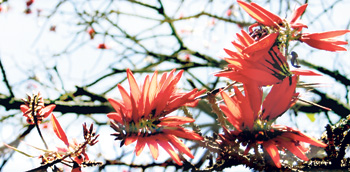“There was a big Erabadu tree near our playground when we were kids. In April, the tree would be bedecked in red blossoms, reminding us of the forthcoming Avurudu. Sadly the tree was cut down few years ago,” says Susantha Kuruwita, an old boy of Mahanama College and keen nature lover, showing us the empty spot on the busy Duplication Road where this tree once stood.
In search of Erabadu, I circulated an email among my friends asking for places where Erabadu trees grew in Colombo. One recalled an Erabadu tree being cut down near Anderson flats. Like many other Avurudu traditions, this symbol too has fallen victim to urbanization.
In the past, Erabadu was commonly used as a fence post. An Erabadu stick grows straight and thorny. It also sprouts easily making it an ideal hedge plant and this made Erabadu abundant in many home gardens in the good old days. “But where do we find fences these days? Almost all houses have parapet walls,” Susantha points out. Having a garden is also a luxury for most Colombo citizens.
In rural areas, especially in the dry zone, Erabadu still survives. Sri Lanka has two Erabadu species that are indigenous, but they are getting rarer according to botanists. The one that is commonly referred to as the messenger of New Year is known as the Indian Coral Tree (Erythrina variegate). The bright red flower (inflorescence) that resembles a tiger claw blooms from February to April, coinciding with the Avurudu season and this was why, probably, our ancestors called it a messenger of the New Year.
The other native Erabadu species is even rarer. Dr. Syril Wijesundara, Director General of the National Botanical Gardens says he has found it only in a few places. This Erabadu species, is known as Yak Erabadu, (Erythrina fusca). “Many consider Erabadu as a useless tree and if that thinking continues, both species of Erabadu will become rare in areas where people live,” warns Dr. Wijesundara.
But Erabadu is not without its uses. The tender leaves of Erabadu can be made into a curry that is famous among villagers. Mature leaves can be a useful nutrient-rich cattle fodder. The bark and leaves are used in Ayurveda as a medicinal substance. The wood is not strong enough to be used as a building material, but in India this soft wood is used to make ornaments.
There are also about six exotic Erabadu varieties that are imported to be used for gardening. These don’t grow too tall, but we need to try to plant our native Erabadu as much as possible, emphasized Dr. Wijesundara.
Erabadu is also an important food plant for birds. The flowers are adapted for pollination by birds that feed on its nectar. Erabadu flowers during the dry season play a vital role in sustaining bird species, by providing water, instant energy through sugars and also amino acids and proteins in their floral nectar according to a study done in India. Some species of Erabadu are also used as a host plant by a moth. It is also a legume plant that converts atmospheric nitrogen to mix with soil that can be absorbed by roots. Hence it is a plant that has ecological value.
Colombo still has a few Erabadu trees that have survived the axe of urbanization and Ruk Rakaganno, the tree society of Sri Lanka, also stress the need to protect them. “Sometimes people cut off trees like Erabadu, thinking these are useless. But it is very important to think twice before cutting any trees,” says a member of the society.
A disease that can damage the Erabadu, causing its bark to get black and the branches to become stunted has also been observed. A tree that has been affected still survives in the Fifth Lane neighbourhood in Colombo 3.
The authorities were alerted, but to-date there has been no response, says the Ruk Rakaganno member. It is the duty of the city authorities to look after the remaining Erabadu trees in Colombo and perhaps, the Colombo Municipal Council should take the first steps this Avurudu to plant Erabadu trees in places like Vihara Maha Devi Park, to keep this beautiful symbol of the New Year alive for the next generation. |

